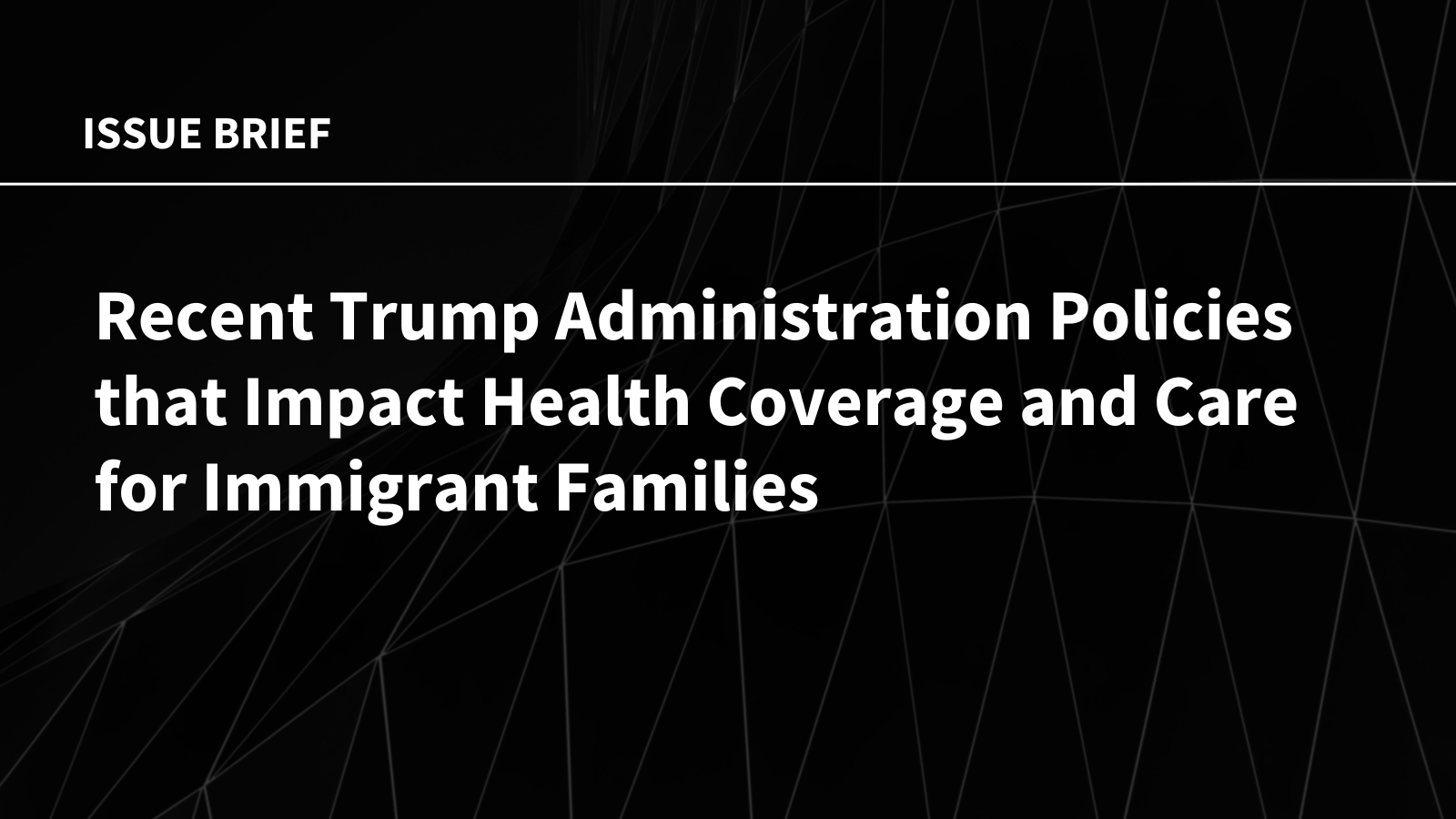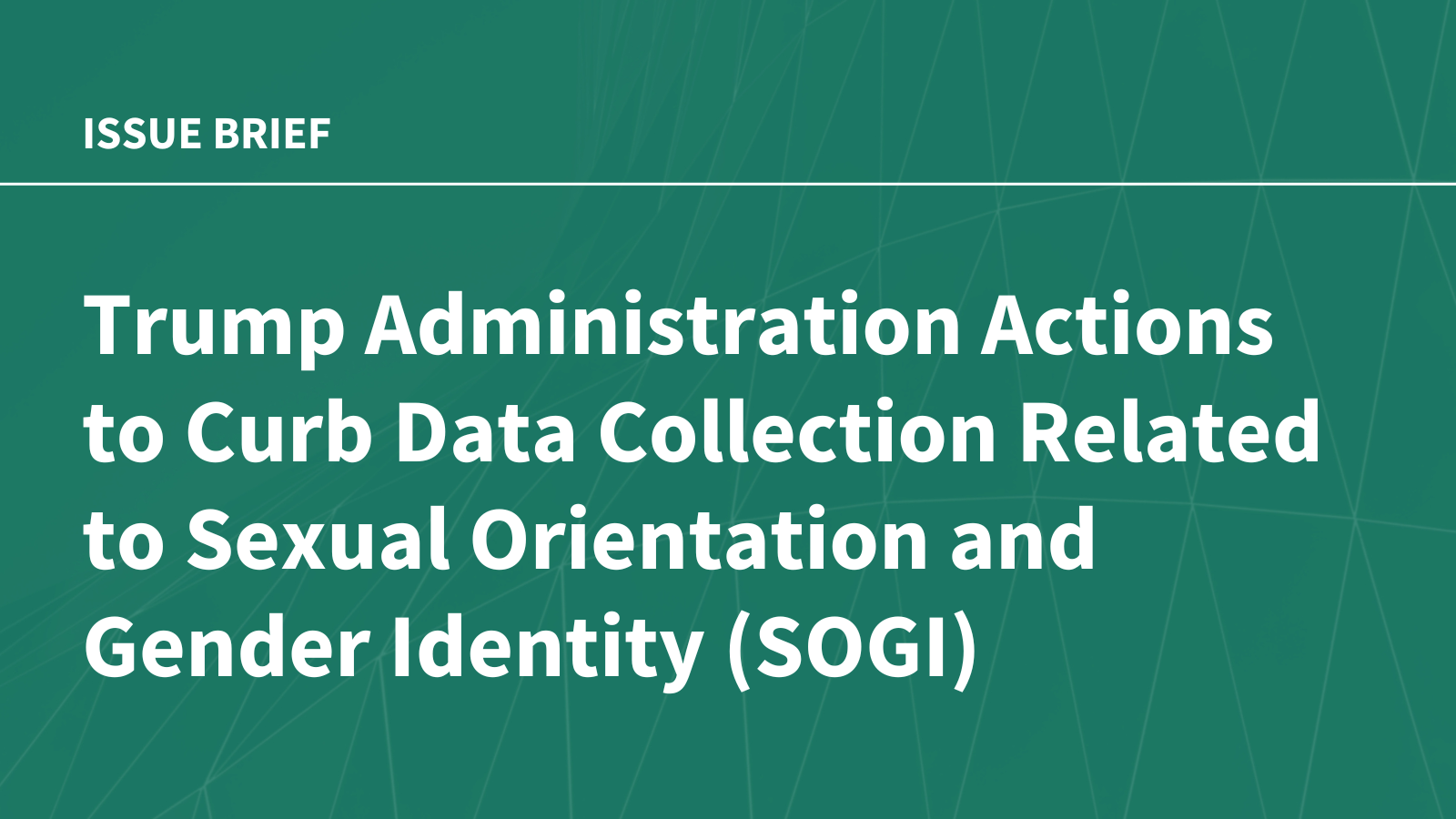Introduction
Immigrants form a growing share of the U.S. population and workforce, and as of 2024, there were over 50 million immigrants residing in the country. President Trump’s agenda has focused on restricting immigration and enhancing immigration enforcement, which research shows has negative impacts on the mental and physical health of immigrant families, including the millions of U.S. citizen children living in them, as well as broader economic effects on communities. The Trump administration and Congress also have made policy changes that further restrict access to health coverage and care for immigrant families.
This issue brief provides an overview of Trump administration and Congressional actions that are likely to impact immigrants’ access to health coverage and care, including new restrictions on eligibility for health coverage and services as well as changes in immigration enforcement and other policies. Together, these changes will likely increase uninsured rates and reduce access to care among immigrants and their children. Over the long-term, these changes may also lead to worse health outcomes and have negative impacts on the U.S. economy and workforce, given the major role immigrants play, particularly in certain industries, including health care, agriculture, and construction.
Reductions in Access to Health Coverage
The 2025 tax and budget law includes significant cuts to the Medicaid program as well as eligibility restrictions that make many lawfully present immigrants (LPIs) ineligible for Medicaid and the Children’s Health Insurance Program (CHIP), subsidized coverage through the Affordable Care Act (ACA) Marketplaces, and Medicare coverage. Under the new law (H.R.1), eligibility for Medicaid and CHIP, subsidized Marketplace coverage, and Medicare will be limited to lawful permanent residents (LPRs or “green card” holders), Cuban or Haitian entrants, and citizens of Compact of Free Association (COFA) residing in the U.S (Table 1). States can also maintain Medicaid and CHIP coverage for lawfully residing pregnant people or children covered through a state option as well as through the “From-Conception to End of Pregnancy” option, which provides coverage to low-income children regardless of their parent’s immigration status. This change will make many groups of lawfully present immigrants ineligible for coverage, including refugees, asylees, people with Temporary Protected Status (TPS), as well as individuals on work visas, among others. The law also eliminates eligibility for subsidized ACA Marketplace coverage for all lawfully present immigrants with incomes below 100% of the federal poverty level (FPL) who do not qualify for Medicaid coverage due to immigration status. The Congressional Budget Office (CBO) estimates that these coverage restrictions will result in 1.4 million LPIs becoming uninsured with $131 billion in reduced federal spending and $4.8 billion in increased federal revenues by 2034. There is no effect on coverage of undocumented immigrants, who are already ineligible for all federally funded health coverage. Some states use their own money to provide health coverage to undocumented immigrants.
The new eligibility restrictions for lawfully present immigrants have staggered implementation dates. The eligibility restrictions for Medicare became effective July 4, 2025 (the date that the 2025 tax and budget law was enacted), and current beneficiaries subject to the new restrictions will be disenrolled from coverage no later than 18 months from enactment of the legislation (January 4, 2027). Eligibility for subsidized ACA Marketplace coverage for lawfully present immigrants with incomes below 100% FPL ends January 1, 2026, while the other restrictions for subsidized ACA Marketplace coverage take effect as of January 1, 2027. The eligibility restrictions for Medicaid and CHIP go into effect October 1, 2026 (Table 2).
Beyond changes in the law, enhanced premium tax credits are set to expire at the end of 2025, which will make coverage unaffordable for many immigrants and likely lead to coverage losses. Without renewal of the enhanced tax credits, average premiums could rise by over 75%, and in some states, they may even double. As a result, total Marketplace enrollment is projected to fall from 22.8 million in 2025 to 18.9 million in 2026 and 15.4 million by 2030. Without enhanced subsidies, many immigrants who remain eligible could lose access to affordable coverage, particularly in states that have not expanded Medicaid to adults.
Some states also have reduced or eliminated state-funded coverage designed to fill gaps in federally funded coverage for immigrants. Three states (California, Illinois, and Minnesota) plus D.C. have recently proposed or enacted budgets to end or limit new enrollment of adults in state-funded health coverage programs for immigrants regardless of immigration status as part of broader efforts to reduce state budget deficits.
Regulations published by the Trump Administration in June 2025 eliminated ACA Marketplace eligibility for Deferred Action for Childhood Arrivals (DACA) recipients on August 25, 2025. Under earlier policy, individuals with DACA status were not considered lawfully present for purposes of health coverage eligibility and remained ineligible for Medicaid, CHIP, and ACA Marketplace coverage despite having a deferred action status, which otherwise qualified for Marketplace coverage. These eligibility restrictions left DACA recipients ineligible for federally funded health coverage programs. The Biden administration published regulations that made DACA recipients newly eligible to purchase ACA Marketplace coverage with premium tax credits and cost sharing reductions beginning November 1, 2024. Following legal challenges, implementation of the Biden administration regulations was limited to 31 states and D.C. New regulations published by the Trump administration once again made DACA recipients in all states and D.C. ineligible for ACA Marketplace coverage. Most states will terminate coverage for enrolled DACA recipients on September 30, 2025.
The Trump administration published new guidance regarding verification of citizenship and immigration status of Medicaid enrollees, which could contribute to disenrollment due to challenges providing documentation. According to the Centers for Medicare and Medicaid Services (CMS), states will be required to separately verify the citizenship or immigration status of individuals whose status cannot be confirmed through federal databases such as the Systematic Alien Verification for Entitlements (SAVE) system based on monthly enrollment reports. Under already existing policies, in addition to meeting other eligibility requirements, lawfully present immigrants must have a “qualified non-citizen” status to be eligible for Medicaid or CHIP, and many, including most lawful permanent residents or “green card” holders, must wait five years after obtaining qualified status before they may enroll. States already are required to verify citizenship and immigration status with the Social Security Administration (SSA) and the Department of Homeland Security (DHS) SAVE system to determine eligibility for Medicaid coverage at the initial application and provide Medicaid benefits to applicants during a “reasonable opportunity period” of 90 days while their immigration status is being verified, if they otherwise meet all eligibility criteria. Although some implementation details of the new verification process announced by CMS remain unclear, it is possible that states will need to re-verify the eligibility of enrollees identified in reports and applicants may need to provide paperwork as proof of their eligible immigration status for manual verification, which could increase administrative burdens on both states and applicants or enrollees and potentially lead to coverage losses due to administrative challenges.
Restricted Access to Health and Other Services
The Trump administration issued a policy change that expands the list of health and other service programs that certain immigrants are prohibited from accessing. On July 14, 2025, the U.S. Department of Health and Human Services (HHS) issued a notice of a policy change to update the definition of “federal public benefits” as outlined in the Personal Responsibility and Work Opportunity Reconciliation Act of 1996 (PRWORA) to add an additional 13 programs to the 31 programs considered “federal public benefits” that are restricted to individuals with a “qualified” immigration status. The notice further indicates that the updated list of federal benefits is not exhaustive, and additional programs may be added in the future. Among the 13 new programs added to the list are Head Start, the Health Center Program, and the Title X family planning program, among others (Box 1). This change bars many groups of lawfully present immigrants as well as undocumented immigrants from accessing several health care, educational, and other social services and will likely have negative impacts on the health and well-being of immigrant families. It also may create new challenges and complexities for service providers. This policy change was expected to take effect immediately upon publication of the notice in the federal register on July 14, 2025, although it provided for a 30-day comment period. However, the HHS had to delay implementation until September 11, 2025, following court orders. Further, on September 10, 2025, a District Court issued an injunction on the administration’s new policy, blocking the implementation of the policy as it relates to the Health Center Program and Head Start in 20 states and D.C.
Box 1: New Programs Considered “Federal Public Benefits” Under the 2025 Policy Change
- Certified Community Behavioral Health Clinics
- Community Mental Health Services Block Grant
- Community Services Block Grant (CSBG)
- Head Start
- Health Center Program
- Health Workforce Programs not otherwise previously covered (including grants, loans, scholarships, payments, and loan repayments)
- Mental Health and Substance Use Disorder Treatment, Prevention, and Recovery Support Services Programs administered by the Substance Abuse and Mental Health Services Administration
- Projects for Assistance in Transition from Homelessness Grant Program
- Substance Use Prevention, Treatment, and Recovery Services Block Grant
- Title IV-E Educational and Training Voucher Program
- Title IV-E Kinship Guardianship Assistance Program
- Title IV-3 Prevention Services Program
- Title X Family Planning Program
- List is not exhaustive and may be added to in the future
Source: U.S. Department of Health and Human Services (July 2025), “HHS Bans Illegal Aliens from Accessing its Taxpayer-Funded Programs”
Enhanced Immigration Enforcement
President Trump also has increased immigration enforcement activity to support mass deportation and detention, which research shows negatively impacts the health and well-being of immigrant families. The administration has shifted enforcement actions from focusing on criminals and recent border crossers to prioritizing all of the estimated 14 million undocumented immigrants for deportation, even though many have some form of temporary deportation protections. As a result, there have been increased worries about detention and deportation among immigrants, including among naturalized citizens, and immigrant families with undocumented immigrants report that immigration-related fears have worsened their mental health and well-being. KFF survey data from March 2025 find that about a third (32%) of immigrants overall say they have experienced negative health repercussions due to worries about their own or a family member’s immigration status (Figure 1). Immigrants also reported they avoided seeking health care due to concerns about costs and fears, were fearful of accessing public programs, and were confused whether these programs can negatively impact immigration status.
In January 2025, the Trump administration rescinded longstanding protections that prohibited immigration enforcement action in certain areas including health care facilities, schools, and places of worship. Based on a memorandum originally issued by the Director of U.S. Immigration and Customs Enforcement (ICE) in 2011, immigration enforcement actions were prohibited from occurring in “sensitive locations” such as health care facilities, schools, and places of worship, with limited exceptions. In 2021, the Biden administration issued an updated memorandum further strengthening and expanding these protections by including disaster relief areas and other sites of essential services on the list of “sensitive locations”. Following the recission of these longstanding protections by the Trump administration, there have been reports of ICE agents showing up at hospitals. Some health care facilities have invested resources into training staff on how to comply with the new policy. Health care providers also have expressed concerns about the new policy deterring individuals in immigrant families from seeking health care. In KFF focus groups conducted with likely undocumented Hispanic immigrants, several participants talked about avoiding seeking health care due to concerns about potential enforcement risks.
Immigration-related worries may be exacerbated by the Trump administration’s actions to share Medicaid enrollee information with enforcement officials. In June 2025, there were reports of the Trump administration sharing the personal and health data of noncitizen Medicaid enrollees with the DHS for purposes of immigration enforcement despite concerns related to the violations of federal and state data privacy protections. A federal court in California issued a preliminary injunction in August 2025 that temporarily blocks the Trump administration from sharing enrollee data for the purposes of immigration enforcement in 20 states that filed a lawsuit against the administration. Breaches or sharing of Medicaid enrollees’ information for purposes other than the provision of health coverage and care pose risks for individuals and may jeopardize confidence in the security of data held by agencies. They may also exacerbate immigration-related fears, potentially leading to immigrants and their children foregoing enrollment in health coverage or seeking health care.
Reducing Federal Language Access Resources
On March 1, 2025, President Trump signed Executive Order 14224 designating English as the official language of the United States with subsequent guidance suggesting the elimination or phasing out of some language access services. The Trump administration’s actions represent a departure from previous administrations’ policies around language access, and it is the first time in the country’s history that the U.S. has declared an official language at the federal level. Based on an accompanying fact sheet released by the administration, all services currently offered in other languages will be reviewed, and non-necessary services will be phased out. However, the Executive Order also states that federal agencies or other agencies that receive federal funding, such as hospitals and doctors’ offices, are not required to stop existing language services due to existing laws and regulations which supersede this guidance. Data from the 2023 KFF Survey of Immigrants find that about half (47%) of immigrant adults report having limited English proficiency (LEP) and that immigrant adults with LEP are more likely than their English proficient counterparts to report barriers to accessing health care and to have worse self-reported health. Reduced availability of language access resources could exacerbate the challenges immigrants with LEP already face and negatively impact their health and health care.
Publisher: Source link









